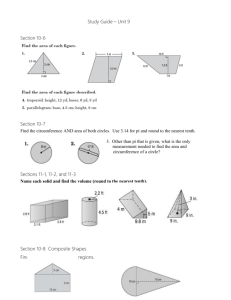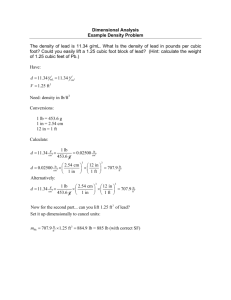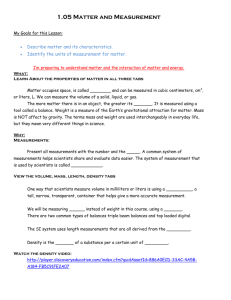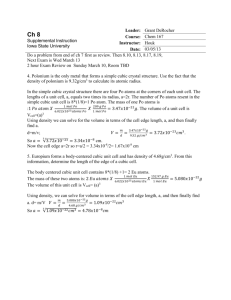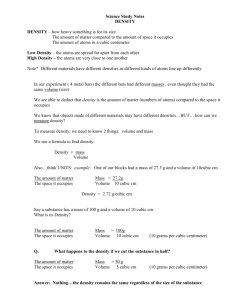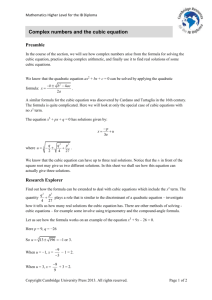Density
advertisement
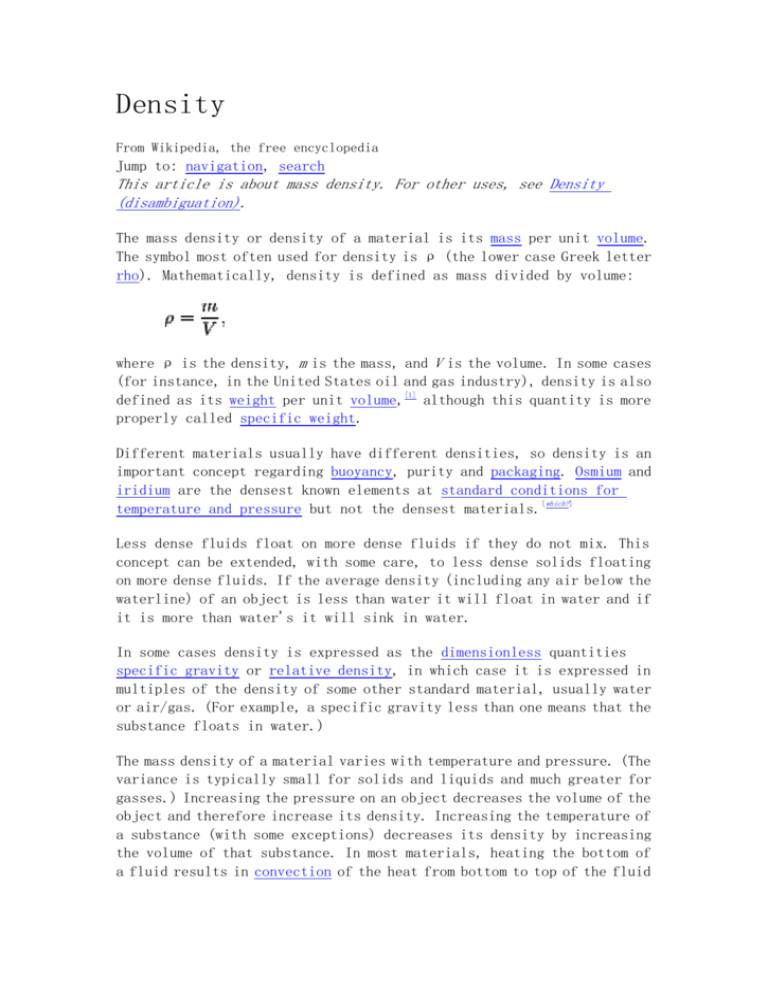
Density From Wikipedia, the free encyclopedia Jump to: navigation, search This article is about mass density. For other uses, see Density (disambiguation). The mass density or density of a material is its mass per unit volume. The symbol most often used for density is ρ (the lower case Greek letter rho). Mathematically, density is defined as mass divided by volume: where ρ is the density, m is the mass, and V is the volume. In some cases (for instance, in the United States oil and gas industry), density is also defined as its weight per unit volume,[1] although this quantity is more properly called specific weight. Different materials usually have different densities, so density is an important concept regarding buoyancy, purity and packaging. Osmium and iridium are the densest known elements at standard conditions for temperature and pressure but not the densest materials.[which?] Less dense fluids float on more dense fluids if they do not mix. This concept can be extended, with some care, to less dense solids floating on more dense fluids. If the average density (including any air below the waterline) of an object is less than water it will float in water and if it is more than water's it will sink in water. In some cases density is expressed as the dimensionless quantities specific gravity or relative density, in which case it is expressed in multiples of the density of some other standard material, usually water or air/gas. (For example, a specific gravity less than one means that the substance floats in water.) The mass density of a material varies with temperature and pressure. (The variance is typically small for solids and liquids and much greater for gasses.) Increasing the pressure on an object decreases the volume of the object and therefore increase its density. Increasing the temperature of a substance (with some exceptions) decreases its density by increasing the volume of that substance. In most materials, heating the bottom of a fluid results in convection of the heat from bottom to top of the fluid due to the decrease of the density of the heated fluid. This causes it to rise relative to more dense unheated material. The reciprocal of the density of a substance is called its specific volume, a representation commonly used in thermodynamics. Density is an intensive property in that increasing the amount of a substance does not increase its density; rather it increases its mass. Contents [show] · [edit] History In a well-known but probably apocryphal tale, Archimedes was given the task of determining whether King Hiero's goldsmith was embezzling gold during the manufacture of a golden wreath dedicated to the gods and replacing it with another, cheaper alloy.[2] Archimedes knew that the irregularly shaped wreath could be crushed into a cube whose volume could be calculated easily and compared with the mass; but the king did not approve of this. Baffled, Archimedes took a relaxing immersion bath and observed from the rise of the water upon entering that he could calculate the volume of the gold wreath through the displacement of the water. Upon this discovery, he leaped from his bath and went running naked through the streets shouting, "Eureka! Eureka!" (Εύρηκα! Greek "I found it"). As a result, the term "eureka" entered common parlance and is used today to indicate a moment of enlightenment. The story first appeared in written form in Vitruvius' books of architecture, two centuries after it supposedly took place.[3] Some scholars have doubted the accuracy of this tale, saying among other things that the method would have required precise measurements that would have been difficult to make at the time.[4][5] From the equation for density (ρ = m / V), mass density must have units of a unit of mass per unit of volume. As there are many units of mass and volume covering many different magnitudes there are a large number of units for mass density in use. The SI unit of kilogram per cubic metre (kg/m3) and the cgs unit of gram per cubic centimetre (g/cm3) are probably the most common used units for density. (The cubic centimeter can be alternately called a millilitre or a cc.) 1,000 kg/m3 equals one g/cm3. In industry, other larger or smaller units of mass and or volume are often more practical and US customary units may be used. See below for a list of some of the most common units of density. Further, density may be expressed in terms of weight density (the weight of the material per unit volume) or as a ratio of the density with the density of a common material such as air or water. [edit] Measurement of density The density at any point of a homogeneous object equals its total mass divided by its total volume. The mass is normally measured with an appropriate scale or balance; the volume may be measured directly (from the geometry of the object) or by the displacement of a fluid. For determining the density of a liquid or a gas, a hydrometer or dasymeter may be used, respectively. Similarly, hydrostatic weighing uses the displacement of water due to a submerged object to determine the density of the object. If the body is not homogeneous, then the density is a function of the position. In that case the density around any given location is determined by calculating the density of a small volume around that location. In the limit of an infinitesimal volume the density of an inhomogeneous object at a point becomes: ρ(r) = dm/dV, where dV is an elementary volume at position r. The mass of the body then can be expressed as The density of granular material can be ambiguous, depending on exactly how its volume is defined, and this may cause confusion in measurement. A common example is sand: if it is gently poured into a container, the density will be low; if the same sand is then compacted, it will occupy less volume and consequently exhibit a greater density. This is because sand, like all powders and granular solids, contains a lot of air space in between individual grains. The density of the material including the air spaces is the bulk density, which differs significantly from the density of an individual grain of sand with no air included. [edit] Changes of density Main articles: Compressibility and Thermal expansivity In general, density can be changed by changing either the pressure or the temperature. Increasing the pressure always increases the density of a material. Increasing the temperature generally decreases the density, but there are notable exceptions to this generalization. For example, the density of water increases between its melting point at 0 °C and 4 °C; similar behavior is observed in silicon at low temperatures. The effect of pressure and temperature on the densities of liquids and solids is small. The compressibility for a typical liquid or solid is 10 −6 bar−1 (1 bar = 0.1 MPa) and a typical thermal expansivity is 10−5 K−1. This roughly translates into needing around ten thousand times atmospheric pressure to reduce the volume of a substance by one percent. (Although the pressures needed may be around a thousand times smaller for sandy soil and some clays.) A one percent expansion of volume typically requires a temperature increase on the order of thousands of degrees Celsius. In contrast, the density of gases is strongly affected by pressure. The density of an ideal gas is where M is the molar mass, P is the pressure, R is the universal gas constant, and T is the absolute temperature. This means that the density of an ideal gas can be doubled by doubling the pressure, or by halving the absolute temperature. In the case of volumic thermal expansion at constant pressure and small intervals of temperature the dependence of temperature of density is : where is the density at a reference temperature, expansion coefficient of the material. [edit] Density of water (at 1 atm) See also: Water density is the thermal Temp (°C) Density (kg/m3) 100 958.4 80 971.8 60 983.2 40 992.2 30 995.6502 25 997.0479 22 997.7735 20 998.2071 15 999.1026 10 999.7026 4 999.9720 0 999.8395 −10 998.117 −20 993.547 −30 983.854 The values below 0 °C refer to supercooled water. [edit] Density of air (at 1 atm) Main article: Density of air Density vs. temperature T (°C) ρ (kg/m3) −25 1.423 −20 1.395 −15 1.368 −10 1.342 −5 1.316 0 1.293 5 1.269 10 1.247 15 1.225 20 1.204 25 1.184 30 1.164 35 1.146 [edit] Density of solutions The density of a solution is the sum of mass (massic) concentrations of the components of that solution. Mass (massic) concentration of each given component ρi in a solution sums to density of the solution. Expressed as a function of the densities of pure components of the mixture and their volume participation, it reads: [edit] Densities of various materials Further information: Orders of magnitude (density) Unless otherwise noted, all densities given are at standard conditions for temperature and pressure. Material ρ (kg/m3) Notes Air 1.2 At sea level Aerographite 0.2 *[6][7] Metallic microlattice 0.9 * Aerogel 1.0 * Styrofoam 75 Approx.[8] liquid hydrogen 70 At ~ -255°C Cork 240 Approx.[8] Lithium 535 Wood 700 Seasoned, typical[9][10] Potassium 860 [11] Sodium 970 Ice 916.7 Water (fresh) 1,000 Water (salt) 1,030 Plastics 1,175 Tetrachloroethene 1,622 Magnesium 1,740 Beryllium 1,850 Glycerol 1,261 Silicon 2,330 Aluminium 2,700 Diiodomethane 3,325 Diamond 3,500 Titanium 4,540 Selenium 4,800 Vanadium 6,100 Antimony 6,690 Zinc 7,000 Chromium 7,200 Manganese 7,325 Tin 7,310 Iron 7,870 Niobium 8,570 Cadmium 8,650 At temperature < 0°C Approx.; for polypropylene and PETE/PVC [12] liquid at room temperature Approx. Material ρ (kg/m3) Cobalt 8,900 Nickel 8,900 Copper 8,940 Bismuth 9,750 Molybdenum 10,220 Silver 10,500 Lead 11,340 Thorium 11,700 Rhodium 12,410 Mercury 13,546 Tantalum 16,600 Uranium 18,800 Tungsten 19,300 Gold 19,320 Plutonium 19,840 Platinum 21,450 Iridium 22,420 Osmium 22,570 Notes *Air excluded when calculating density [edit] Other densities Entity ρ (kg/m3) Notes Interstellar medium 10E-20 Assuming 90% H, 10% He; variable T The Earth 5,515.3 Mean density The Inner Core of the Earth 13,000 Approx.; as listed in Earth White dwarf star 10E+8 Approx.[13] Neutron star 10E+17 Atomic nuclei 2.3E+17 Does not depend strongly on size of nucleus[14] Black hole 4E+17 Mean density inside the Schwarzschild radius of an Earth-mass black hole (theoretical) [edit] Other common units The SI unit for density is: · kilograms per cubic metre (kg/m3) Litres and metric tons are not part of the SI, but are acceptable for use with it, leading to the following units: · · · kilograms per litre (kg/L) grams per millilitre (g/mL) metric tons per cubic metre (t/m3) Densities using the following metric units all have exactly the same numerical value, one thousandth of the value in (kg/m3). Liquid water has a density of about 1 kg/dm3, making any of these SI units numerically convenient to use as most solids and liquids have densities between 0.1 and 20 kg/dm3. · · · kilograms per cubic decimetre (kg/dm3) grams per cubic centimetre (g/cc, gm/cc or g/cm3) 3 3 o 1 gram/cm = 1000 kg/m megagrams (metric tons) per cubic metre (Mg/m3) In US customary units density can be stated in: · · · · · · · Avoirdupois ounces per cubic inch (oz/cu in) Avoirdupois pounds per cubic inch (lb/cu in) pounds per cubic foot (lb/cu ft) pounds per cubic yard (lb/cu yd) pounds per US liquid gallon (lb/gal) pounds per US bushel (lb/bu) slugs per cubic foot Imperial units differing from the above (as the Imperial gallon and bushel differ from the US units) in practice are rarely used, though found in older documents. The density of precious metals could conceivably be based on Troy ounces and pounds, a possible cause of confusion.


